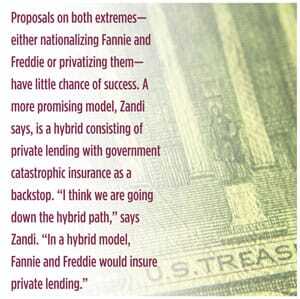Amid the heated rhetoric and complex restructuring proposals, Fannie Mae and Freddie Mac are operating as usual—minus the risky business—and slowly recovering. The improving health of Fannie and Freddie could diminish the sense of urgency regarding their future.
As of this writing, the fate of Fannie Mae and Freddie Mac is uncertain. Republicans and Democrats are in rare agreement that the two government-sponsored enterprises (GSEs) failed in their mission to provide liquidity, stability, and affordability to the housing market and consequently should be either dismantled or radically altered. An examination of the GSEs after they were taken over by the government in 2008 showed that misfeasance in the agencies contributed to their collapse, which in turn threatened to bring down both the U.S. housing market and the world economy. Lawmakers are virtually unanimous in the belief that the public/private Fannie/Freddie model is untenable.
But there is a huge impediment to quick restructuring: without Fannie and Freddie, analysts say, the housing market would be undermined. Close to 90 percent of all mortgages being written are guaranteed by Fannie, Freddie, or the Federal Housing Administration. Private lenders and investors are limiting mortgage lending to only the most qualified borrowers. So while everyone wants change in the relationship between government and the housing market, most analysts say comprehensive restructuring of Fannie and Freddie may be years away. In the meantime, a cherished symbol could be in jeopardy. The American dream of a freestanding cozy cottage with a picket fence may be reenvisioned as a prime rental unit in a multifamily dwelling.
The Problem and Possible Solutions
The impetus for the government to expand homeownership opportunities came out of the Great Depression when homeownership rates were low—limited, to a large extent, by wary bankers who viewed mortgage lending as a risky business that tied up reserves for long periods. Fannie Mae—the Federal National Mortgage Association—was created in 1938 as a government agency to ensure that lenders, then primarily banks, had sufficient capital to increase mortgage lending. In 1968, Congress transformed Fannie Mae into a publicly traded, shareholder-owned company whose operations in the secondary mortgage market carried the implicit backing of the federal government. Freddie Mac—the Federal Home Loan Mortgage Corporation—was chartered by Congress in 1970 to provide competition for Fannie Mae. Both GSEs have three business lines—single-family housing, multifamily housing, and capital markets. They buy mortgages from lending institutions, then either hold them in investment portfolios or resell them as mortgage-backed securities to investors.
Their unusual status as private companies whose financial maneuvering carried implicit government guarantees was controversial from the start. As government-chartered entities, they were able to borrow money at lower rates than their private competitors while at the same time competing with those companies to maximize revenues and returns for their shareholders. In their early years, Freddie and Fannie focused on stable 30-year fixed-rate loans and developed a secondary mortgage market that expanded the availability of mortgage loans.
But in the mid-2000s, Fannie and Freddie were caught up in the subprime mortgage lending stampede. Managers at Fannie and Freddie believed it was their fiduciary obligation to private shareholders to participate in a market that was yielding huge profits to their competitors. As has been well-chronicled, the market collapsed and taxpayers were on the hook. In September 2008, the federal government placed Fannie and Freddie in conservatorship after assuming 79.9 percent ownership interest. Since then, taxpayers have injected close to $150 billion to prop up the two companies, and analysts predict an equal sum will be needed in the years to come. The collapse of Fannie and Freddie revealed in dramatic fashion the flaw in the private/profit, socialized risk model.
But overhauling the agencies in the midst of the severe economic downturn is a complex undertaking. With credit markets frozen, Fannie and Freddie have regained their central role in mortgage finance. Fannie and Freddie currently own or insure $5.7 trillion of the $11 trillion U.S. mortgage market, and over the past year they have accounted for about 75 percent of the funds flowing into that market. With nine of ten mortgages receiving a government guarantee of some kind, policy makers, even the GSEs’ most vocal critics, reluctantly agree that removing Fannie and Freddie at this juncture could have catastrophic consequences.
Keeping the Baby and the Bath Water
Although very few are happy about it, Fannie and Freddie will operate as usual for the foreseeable future. Meanwhile, restructuring plans are coming from all points on the political spectrum. Last August, President Obama pledged to produce a restructuring plan for Fannie and Freddie this year that would eliminate the two agencies while still continuing some form of government guarantees. Last fall, congressional Republicans issued a position paper resolving to build a mortgage market that “does not rely on government guarantees” and “does not make private investors and creditors wealthy while saddling taxpayers with losses.” In a distinctly minority view, some Democrats still support Fannie and Freddie as currently structured, insisting that although management led them astray, the companies fulfilled the function intended—expanding the availability of mortgage loans to a wider range of income levels.
Republican victories in the 2010 elections, which added many new members who made elimination of the GSEs a central issue in their campaigns, along with the legal mandate that the government end its support for the companies by the end of 2012, ensure that debate will rage and reform proposals will be ubiquitous. In one example that has gained attention, Donald Marron, a Georgetown University professor and former adviser to George W. Bush who was commissioned to study the Fannie/Freddie problem, proposed privatizing the companies—not only eliminating their government support, but also removing their investment portfolio business. Under Marron’s proposal, Fannie and Freddie would be limited to buying conforming mortgages and securitizing them. Government insurance would be provided to back their mortgage securities, the same way it does for a private bank.
Yet, amid the heated rhetoric and complex restructuring proposals, Fannie and Freddie are operating as usual, minus the risky business, and slowly recovering. The improving health of Fannie and Freddie could diminish the sense of urgency regarding their fate.
“I can’t see any significant changes in the near future,” says Mark Zandi, chief economist with Moody’s Analytics, who has participated in discussions of the GSEs with Treasury Secretary Timothy Geithner. Although he believes the Fannie/Freddie model is flawed, he notes that currently, “Fannie and Freddie account for about 50 percent of the mortgages, while the private sector is virtually dormant. There is no alternative to fill the void, so I don’t see changes in the next couple of years.”
Proposals on both extremes—either nationalizing Fannie and Freddie or privatizing them—have little chance of success. A more promising model, Zandi says, is a hybrid consisting of private lending with government catastrophic insurance as a backstop. “I think we are going down the hybrid path,” says Zandi. “In a hybrid model, Fannie and Freddie would insure private lending.”
A potential casualty of this model—as is the case with a number of other models—is the popular low-cost, 30-year, fixed-rate mortgage. Zandi predicts 30-year mortgages will survive, but rates will increase 40 or 50 basis points. Other analysts say costs of the 30-year product will be significantly higher—by as much as 7 percentage points. All agree that a rate increase of any magnitude on 30-year mortgages is likely to lower demand for housing by significantly reducing access to mortgage loans by lower-middle-income households.
As a result, the American dream of homeownership that has inspired policy makers since the Great Depression is likely to take on a different form. “I can see a shift to multifamily housing and rental units,” says Zandi. “The [single-family] homeownership goal was laudable for about 25 years after the Depression, but now circumstances are different.”
Whether or not a new American dream emerges, policy makers will search for a way the government can support the housing market while ensuring that taxpayers are not left holding the bag for risky investment decisions made for private profit.


